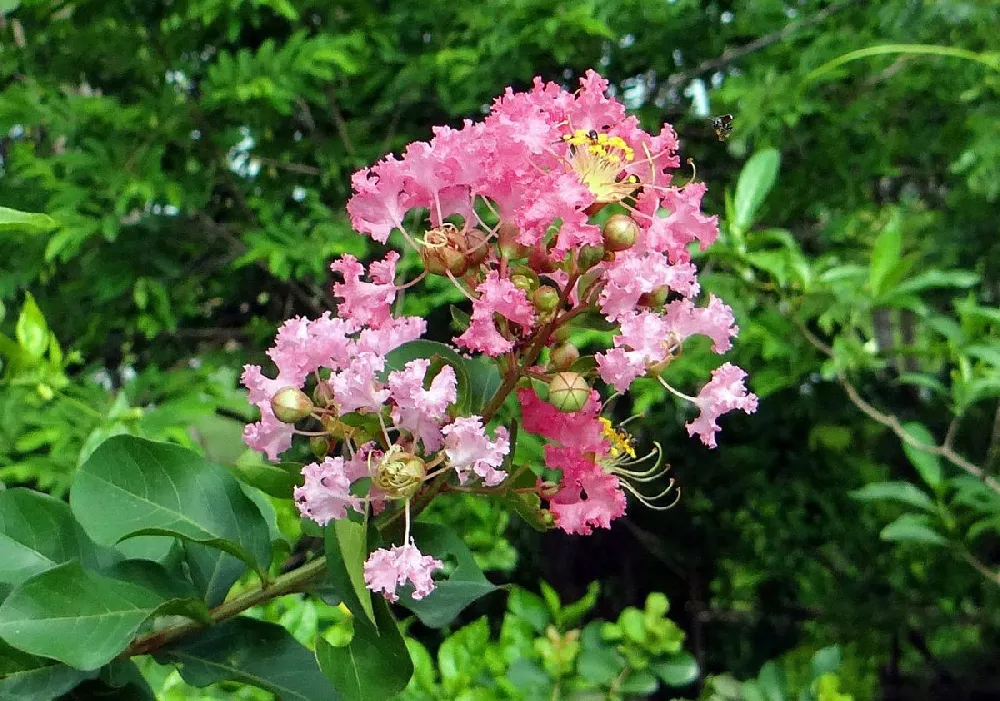Sioux Crape Myrtle for Sale - Buying & Growing Guide
- Ships in 1-2 days
- 1-Year Warranty Eligible
- Pots or accessories are not included unless specified in the product options.
Shipping Details:
Once your order is shipped, you’ll receive an email with a tracking number and estimated delivery date. Most orders ship immediately, but some items are seasonal and may only ship in spring or fall. These products are noted on the website.
If four-season interest is what you're hoping to achieve in your landscape, look no further than the Sioux crape myrtle, Lagerstroemia x 'Sioux'. The colorful displays start in spring with a proliferation of bright green leaves in a bushy canopy. As the temperatures warm, the main show begins: an explosion of light pink flowers that continues throughout the summer. As the flowers finally fade, the tree's fall leaf colors, in spectacular red, orange, and yellow, take center stage. The winter landscape, meanwhile, is brightened by the tree's exfoliating bark, which adds textural, marble-like interest when there's little else on view. Here are some more great reasons to consider adding Sioux crape myrtle to your garden:
- The Sioux crape myrtle is more cold-hardy than most crape myrtles, and it can be grown as far north as coastal New England.
- It can be grown as a single-trunk tree or left to become bush-like, with multiple trunks.
- These fast growers fill in empty spots in your garden quickly, reaching mature height in only a few years.
Plant Care
Sunlight
Sioux crape myrtle does best when planted in full sun; six or more hours of direct light a day.
Watering
Although somewhat drought-tolerant, these trees may need supplemental watering during droughts.
Fertilizing
Feed in the spring with a high-nitrogen fertilizer, such as a 20-10-10 formula, designed for landscape plantings.
Planting and Care
Planting instructions
Site your Sioux crape myrtle in well-draining soil where it will receive at least six hours of sun a day. Unpot your plant, and tease out any encircling roots, which can girdle the tree and slowly kill it. Dig a hole that’s as deep as the root ball and twice as wide. Place the plant in the hole, spreading out the roots. While holding it upright and steady, fill in around the roots with topsoil, tamping down as you go to eliminate air pockets. Water thoroughly. Apply a 2- to 3-inch layer of an organic mulch, such as bark chips, around the root zone to conserve moisture and hinder weed growth.
Watering and nutrients
Water newly-planted crape myrtles several times a week, until you see robust new growth starting to appear. Then cut back to once a week waterings, unless you’re experiencing drought-like conditions. To determine if a mature tree needs water, check the soil 2 inches below the surface. If it’s dry, give your plant a drink. Feed your Sioux crape myrtle in spring with a product that has a higher percentage of nitrogen, such as a 20-10-10 fertilizer.
Pollination
Crape myrtles are self-fertilizing, which means a single plant has both male and female reproductive organs on it. Various insects, including bees and wasps, pollinate the flowers, leading to small seed pods that turn brown and dry out before falling from the tree.
Pruning
Monitor your Sioux crape myrtle and prune out dead, broken, or diseased branches whenever you see them. Prune for shape and size in late winter. You can prune out all but one dominant trunk so that your plant will assume a tree-like shape or leave the four or five strongest trunks, pruning out weaker ones, and let your crape myrtle achieve a bushier shape. It’s also a good idea to remove low-growing lateral branches. Crape myrtles bloom on new wood, so keep your tree well trimmed to ensure good blossoming.
Pests, diseases, and animals
The Sioux crape myrtle is a hearty plant that is not susceptible to pests or diseases. There is, however, an insect called the crape myrtle aphid that is commonly seen on these plants. Release beneficial insects such as ladybugs to counter them, or use horticultural oil or neem oil. Powdery mildew is a disease that is common with crape myrtles, although the Sioux crape myrtle has some resistance. Avoid planting your tree where it is consistently damp or there is poor circulation. Remove any branches that are coated with the white or gray powdery growth.
Achieving maximum results
There are several schools of thought on pruning your crape myrtle. If you wish your plant to become a windbreak or privacy screen, keep pruning to a minimum, taking off only diseased or dead wood. If you’re hoping for maximum blooms, cut back more aggressively. Flowers occur on new wood, so cutting back old wood before the buds set in early winter should lead to voluminous flowering. You can also lop off top branches if you wish to control the growth of your crape myrtle. A mature tree that is well cared for may achieve a height of up to 20 feet, but a shorter appearance is possible by pruning carefully each year.
FAQs
Where can I grow a Sioux crape myrtle?
Can a Sioux crape myrtle be grown in a container?
Yes, but keep in mind that it will most likely remain smaller than a similar tree planted in the ground. Choose a container for your crape myrtle that is roughly twice the size of the root ball, with good drainage in the bottom. You may need to water your plant more often than you would a garden-grown crape myrtle, and you should be sure to feed it throughout the growing season.
How fast does a Sioux crape myrtle grow?
The Sioux crape myrtle is a fast grower and may put on as much as 24 inches of new growth a year if it is being properly cared for and is in a location that suits it. Growth will slow as it reaches its mature height of 15 to 20 feet.
Compare Similar Products
You can't add more Product Name - Product size to the cart.
OK








